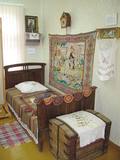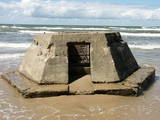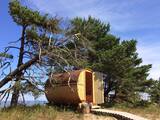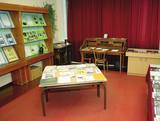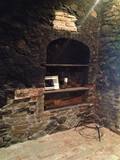| Нo | Название | Описание |
|---|---|---|
|
One of the largest karst areas in Estonia is found here. The unique Witch’s well is one of the most interesting parts of this area. During spring floods (not every year, and for only a short period of time), the well erupts with underground river waters to create an unusually powerful karst stream that can pump out as much as 100 litres per hour.
|
||
|
“Amatnieku namiņš” ir saimnieces izlolota sirds lieta, jeb vieta, kur vienkopus atrodami daudz un dažādi vietējo un apkārtnes novadu amatnieku un mājražotāju darinājumi. Tējas, garšvielas, ievārījumi, dažādi smēriņi, adījumi, kokdarbi, pinumi, ziedi un ziedu kārbas, sveces, krūzes un daudz kas cits ir atrodams tieši “Amatnieku namiņā”. |
||
|
Ģimenes uzņēmums Svētes pagastā, netālu no Jelgavas. Kopš 2019.gada šeit top dažādi Latvijas priežu produkti, kas vērtīgi kā imunitātei, tā arī veselībai. Mītavas Čiekurs produktu galvenā sastāvdaļa ir Parastā priede (Pinus sylvestris). Tā bagāta ar ēterisko eļļu, sveķiem, miecvielām, C vitamīnu u.c. vērtīgām vielām. Tiek gatavotas priežu čiekuru karameles, čiekuru sīrupa zefīri, želejkončas, priežu čiekuru zapte, karamelizēti čiekuri sīrupā, šokolādē, kā arī priežu pumpuru sīrups un tēja. Ekskursija norisinās 90-120 minūtes, kuru laikā atraktīvais saimnieks Reinis pastāstīs par uzņēmuma vēsturi, dalīsies receptēs, pagatavos katram apmeklētājam gardu dāvanu (čiekuru marmelādi), kā arī protams- varēs degustēst dažādos priežu produktus. Papildu pirms vai pēc ekskursijas iespējams ieturēties ar uz ugunskura gatavotu pupiņu zupu ar lauku kūpinājumiem, soļanku vai biešu zupu. Tūristus uzņem nupat uzbūvētajā ekskursiju telpā- Čiekurnīcā. Uzņemt var līdz pat 60 interesentiem reizē. |
||
|
Во вторую субботу каждого месяца (по предварительной договоренности и в другое время) в присутствии хозяина каждый сам может применить свои навыки в копчении рыбы, после чего следует дегустация приготовленной рыбы. |
||
|
Музей истории Малты. Экспозиция „Малтская волость на грани веков от
Розентовы до Боровой и Малты”. Предлагаем ознакомиться с предметами
домашнего обихода, орудиями труда, предметами искусства, коллекцией
денежных знаков. Экскурсия вне музея „На излучинах р. Малты”.
Время работы: 9.00 – 17.00, Сб.,Воскр.: выходные |
||
|
Находятся в центре Нерете, ул. Ригас, 2. Церковь (стиль барокко с признаками поздней готики) считается одним из старших храмов Земгале. Строительство относится к 1584 - 1593 годам, по инициативе графа Вильгельма фон Эферна (перестроена в 1679 г.). В церкви находится кенотаф Вильгельма фон Эферна и надгробная плита Георга фон Эферна, обе относятся к концу 16 века (надгробная плита Г.Эферна - яркий образец художественной работы раннего северного маннеризма в Латвии),созданнаяП. Хандлером алтарная икона (1863 г.), построенный Р. Кнауфом орган (1893 г.), созданные Э.Байерманом оконные витражи (1900 г.), потолочные светильники 17 и 19 веков. Посетители церкви могут осмотреть Нерете и окрестности с высоты 38,6 м своеобразной церковной восьмиугольной башни. |
||
|
The impressive Gauja River valley and its best natural and cultural landscapes can be seen from Paradīze (Gleznotāji) Hill, the Sigulda castle ruins, the aerial tram, the Ferris wheel, the Ziediņi and Pilsēta ski trails, the area of the bobsled and sledding trail, Ķeizarskats, the viewing area of the Velnala cliffs, the mountain bike route of Sigulda (on the right bank of the Gauja, particularly when the trees are bare), the area of the Krimulda castle ruins, Dainu Hill, and the Turaida castle tower.
|
||
|
Маршрут подходит для активных туристов, интересующихся многообразием природной и культурной среды национального парка «Кемери». Национальный парк «Кемери» (основан в 1997 г.) создан, прежде всего, для защиты водноболотных угодий – мелководного побережья Рижского залива, заросших прибрежных озер, болот, влажных лесов (трясин и др.) и пойменных лугов, как значимых мест произростания многих растений (~ 25 % от видов растений, занесенных в Красную книгу Латвии) и обитания животных, особенно мест скопления гнездящихся и перелетных птиц. На территории парка находится один из крупнейших заболоченных массивов Латвии – Большое Кемерское болото. Заболоченные массивы являются значимым местом образования и выхода сероводородных вод, а также местонахождения лечебных грязей, используемых в медицине, которые в свое время послужили основанием для создания известного курорта «Кемери». Информация о маршруте от Latvijas Lauku forums |
||
|
В «Унтуми» содержат и восстанавливают стадо лошадей, и покупают лошадей, которые исторически соответствуют требованиям породы коней, выведенной в Латвии. Здесь на ограниченной площади и на просторах можно научиться основам верховой езды в сопровождении инструктора. Летом предлагается катание в коляске, зимой - в подводе. Лошадей используют на свадьбах и на других торжественных мероприятиях. |
||
|
Atrodas Lielvārdes parkā pie Rumbiņas ietekas Daugavā. Līdzīgi kā citur, arī šeit 13. gs. pirmajā pusē bīskapa pili cēla nodedzinātās lībiešu koka pils vietā. Mūra pili nopostīja Livonijas kara laikā - 1577. g. Tikai 1987. g. notika drupu konservācija. Lielvārdes parka veidošanu uzsāka 19. gs. beigās Lielvārdes muižas barona Artura fon Vulfa vadībā. Sagaidot eposa „Lāčplēsis” simtgadi tajā izvietoja sešpadsmit no ozolkoka veidotas skulptūras (t.s. Skulptūru dārzs) (autori V. Ansavs, P. Mellis, Ē. Delpers, A. Dauvarte). Aiz pilsdrupām Daugavas krastā ir stāva krauja ar dolomīta iežuatsegumu. Līdz HES ūdenskrātuvei var nokļūt pa kāpnēm. Lielvārdes muižas pils līdz mūsdienām nav saglabājusies. |
||
|
Находится на ул. Базницас, д. 5. Здание, покрашенное в темные тона, строилось в XVII в., а в его подвалах размещалась первая городская тюрьма. Находящаяся рядом историческая ратушная площадь была главным местом сбора горожан и местом исполнения наказания, так как в юго-восточном углу площади был установлен позорный столб. Сегодня здесь разместился Кулдигский ТИЦ и ткацкая мастерская, где можно приобрести выпускаемые в Курземе товары и сувениры, а в мастерской понаблюдать за ткацким процессом. В окрестностях ратушной площади снимались кадры кинофильма «Проделки Эмиля». |
||
|
Atrodas Tirdzniecības kanāla dienvidu krastā, kas padomju laikā bija slēgta zona ar pierobežas režīma statusu. Tagad lieliska pastaigu vieta, kur var vērot kuģīšus un jahtas. Promenādes visā garumā izvietojušies vēsturiskie spīķeri. Šeit meklējami krodziņi, viesnīcas, mūzikas klubs, mākslas galerija un Dzintara pulkstenis. |
||
|
Вначале маршрут идет к производителю вина и березового сока, где вы сможете отведать эти традиционные и освежающие напитки, а затем отправляйтесь на козью ферму, где можно дегустировать различные молочные продукты и посмотреть на животных. Затем направляйтесь в Сигулду с ее Олимпийской бобслейной трассой и тремя средневековыми замками, расположенными на берегах реки Гауя – Сигулдой, Турайдой и Кримулдой. Здесь также много живописных троп. Затем откройте для себя историческую деревню Лигатне, основанную вокруг бумажной фабрики, а также посетите местных ремесленников, которые расположились в одной из пещер, типичных для этой местности. Цесис – очаровательный город с его внушительными развалинами средневекового замка и Новым замком. Посетите выращивателя конопли и попробуйте коноплю, приготовленную традиционным способом. Насладитесь визитом на мельницу Кони, где производят шерсть с помощью старинных станков и делают теплые одеяла. Посетите ремесленную студию в Стайцеле и попробуйте разглядеть, где находится колония аистов с более чем 30 гнездами вдоль дороги. В Мазсалаце находится природный парк с тропами вдоль красивых крутых берегов реки Салацы. Река славится своими миногами, и далее на маршруте вы сможете увидеть традиционные запруды для ловли миног. В Саулкрасты пройдитесь по тропе вдоль дюны и насладитесь пляжем. Затем отправляйтесь на клюквенные болота, где сможете отведать эту полезную ягоду в одном из видов, типичных для сезона. Посетите элегантное поместье Бирини с его огромным парком и замечательным рестораном, а затем возвращайтесь в Ригу. |
||
|
От батареи до наших дней сохранились остатки железобетонного дзота, которые в результате длительного воздействия ветра и волн, омывавших берег, сползли до самого пляжа. Вызывающий интерес исторический памятник, чья судьба на протяжении длительного времени была предсказуема, – скрылся ниже уровня моря.
|
||
|
"Anima Candles" sveces ir roku darbs. Svecēm pieejami vairāki dizaini, kas variē gan krāsās, gan izgatavošanas metodē. Krāsu un smaržu klāsts ir plaši pieejams. Tās izgatavotas no pārtikas rūpniecībā izmantojamā parafīna vai ekoloģiskās sojas. Sveču ražotnē tiek piedāvātas sveču liešanas meistarklases.
|
||
|
Atrodas 0,5 km ziemeļaustrumos no Dzērbenes baznīcas, ceļa otrajā pusē. Vizuāli izteiksmīgs pilskalns ar 50 x 50 m lielu plakumu, kura kultūrslānī atrastas vēlā dzelzs laikmeta apmetnes atliekas. Pilskalna rietumu nogāzē ir izveidots ceļš, pa kuru nonāksim līdz tā plakumam ar estrādi. |
||
|
Место для отдыха Лаймес майя находится в очень красивом месте у самого берега моря – на мысе Колка. Здесь у вас будет возможность отдохнуть, наблюдать за закатами и восходами, наслаждаться морем, тишиной и покоем. Дом Лаймес – это экологическая постройка цилиндрической формы из еловой древесины с большим круглым зеркальным окном. У дома Лаймес характерная форма круглой бочки, что придает ей оригинальность и красивый дизайн. На одном конце дома расположено большое полукруглое окно, через которое открывается красивый пейзаж за окном. Кровать в доме расположена прямо у окна, для того, чтобы предоставить незабываемые, романтические ощущения при единении с окружающим пейзажем и природой. |
||
|
Музей Берзгальской волости был основан в 1988 году. В
музее расположена мемориальная комната писателя Антона
Рупайниса (1906 – 1976), экспозиция об истории волости, о
знаменитых людях, культурно-исторических традициях.
Время работы: Пн.– П.: 9.00 – 12.00,13.00 – 17.00, Сб., Воскр.: по договоренности |
||
|
Народный дом расположен в здании, построенном в середине 18-го века, в котором находился трактир. Для сохранения этого более чем 135-летнего здания культурно-исторического наследия в 2011 году в нем были проведены масштабные реставрационные работы. В настоящее время в Народном доме устраиваются различные мероприятия, для посетителей открыт выставочный зал и краеведческое пространство - «Комната старинных вещей». |
||
|
This is a cemetery that was originated in the Middle Ages and used until the beginning of the 20th century. A mossy stone fence surrounds the cemetery. Interesting elements in the cemetery include the grave of Heinrihs Jakobsons (1832-1911), who was the first schoolteacher in Mazirbe (the old metal cross is to the left of the main gate), a pine tree of national importance and has a circumference of 3.17 metres (during the Soviet Union someone drilled a hole in the trunk of the tree to access honey), the grave of Niks Freimanis (1845-1908), who is said to have been the prototype for a character in a story and play by Marģers Zariņš, and the Werewolf Grave, which relates to countless ghost stories, including the claim that it is the only known gravesite of a werewolf in Latvia. |
||







